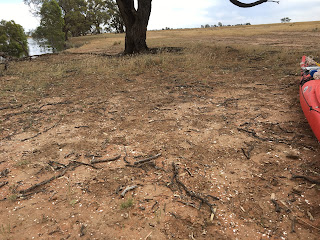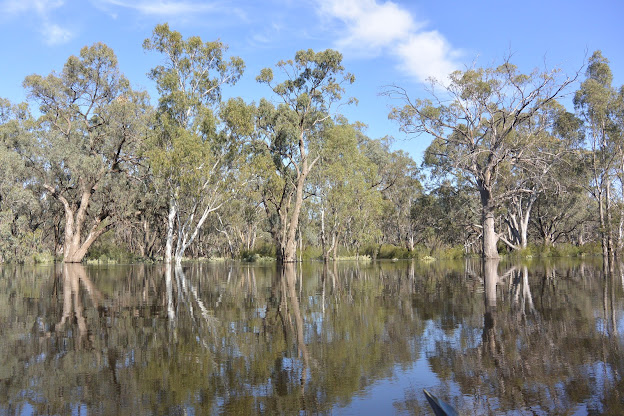Day 47: 338 km Morgan 1st Dec 2016
Leaving the Murray River Queen - morning light - birds of prey - Big Toulca Flat - Woodcutters Reach - Lock 2 - Undercurrents - Bartels Landing - Floating seeds - Riverleigh Station - Tree health - Tipping points - North-West Bend - Morgan - Paddlesteamers & Wharf
Waikerie to Morgan
I left Waikerie early, before anyone else on the boat was up. The sun was up, it had risen about 5:30 and I had gotten up not long after that. Keeping breakfast simple, a couple of muesli bars, some fruit and a cup of tea, I was ready to push off at 7:30.
The light was beautiful and clear. That together with the smooth surface of the water and still flow out a real spring in my step. Morning light is not as harsh as what it is during the main part of the day. The colours come out. It's when you see just how amazing the bark on red gums can be. Paddling out of town, I passed a long row of houseboats waiting for their next outing, their next passage of discovery.
Whistling Kites have been the most common bird of prey along the river this year. There never used to be so many when I was a kid, but there were more Wedge-tailed Eagles. I don't know what has changed, perhaps they benefit from having fishermen around. Once the cliffs begun, Falcons started to appear. They like to sit at the top of trees on the cliff face and swoop down on their prey, which I imagine, could be any small bird or marsupial. All the more amazing when I saw a Fairy Martin chasing a falcon. It was swooping again and again on the falcon, pecking it on the back. While the falcon tried to get away. Brave little bird.
Again today they were great names like what coverage and Big Toluca Flat and Woodcutter Reach. I guess I shouldn't of been surprised when there weren't very few old trees on Woodcutters Reach.
All along the river I can hear the sounds of people raiding their pumps in preparation for the high water. Occasionally i can hear the voices of fruit pickers drifting down from amongst the orange orchards, however I can rarely see them.
Approaching Lock 2, the navigation pass is open. I can see that the water is at the top of the weir. It splashes up in the air ominously. To go that way would be very dangerous. At Wentworth weir, a tinny was caught in the turbulence behind the wall. The back end went under first, filling the boat with water. Soon the whole boat disappeared, only to resurface 100m downstream. There are signs which slow you where to go to be in the safe passage. You keep right of the green triangle (when going downstream) and left of the red squares. There are some pretty big swirls for the first 200m. If you keep under power (keep paddling) you come through it without too many involuntary course changes.
At Bartels Landing were two old farm houses and in front of them, an eclectic collection of boats. Both farm houses had orange groves behind them as is the old tradition in the area. A little further down stream is a vineyard. In the 1980s when the Australians discovered that there were other beverages besides beer, the Riverland wine industry boomed. It expanded till it seemed that everyone wanted to get into wine. In the late 90s and 2000 the wine industry crashed and with so many suppliers, prices plummeted. Now with quality assurance, interesting boutique wines evolving and export markets established, the wine industry is picking up again. Although there were only two houses there were about 6 boats. I love seeing people's boats, there is so much of their character that you can read in them and each boat has its own story as well. At Bartels Landing was one which looked like it had a proud history. Long and sleek, it's wooden hull looked more at home in the ocean then on the river. Seeing ocean boats is a common thing down this end of the Murray, it is so wide and deep and we're not all that far from the ocean. I now have around 360 km to go - that's a lot less than 2200 and I can feel that the end is getting near.
Approaching Riversleigh Station I can see the cliffs curving away to the North. The land in between them and the current river channel is low and beginning to flood. There's a lack of trees on that flat what trees I can see seem to be dead. On the edge of the river young red gums have sprouted following the 2011 flood. This high water event is predicted to be much higher in this area so all of that low land will get a drink, indeed the water is well on its way to flooding the whole area already. It will be interesting to see how it responds in the years to come. Red gum and black box seeds are carried by water over the land from parent trees. You can pick the extent of a high water level from the line of red gum saplings at its edge. The thickness and height of the saplings and later trees gives you an indication of when that flood happened. The rule of thumb is a centimetre a year. A four centimetre thick tree germinated 4 years ago (2012), a 50 cm thick one, about 50 years ago.
I camped opposite Riversleigh Station in 2012, above the beach and under some study black box trees. It had been really hot that day, thunderstorms were building and I chose what I thought was a safe campsite. I had just set up camp and had a cooling swim when the thunderstorm hit. With it came wild winds. Lightning flashed continually and my little tent was buffeted in all directions. When it hit nearby, it left a strong smell of ozone in the air for a while afterwards. It was gone soon after it began. I remember a cockatoo screeching as it flew. From the noises it was making it sounded like it had scored a direct hit. The poor thing had been scared out of his wits. After the thunderstorm, the sun set over the now flooded lowland across the river, turning the sky gentle hues of pink and purple. The trees at the beach campsite, despite four years of good rain, did not look any better than they did in 2012, if anything they seem to have declined further. If trees experiencing prolonged stress reach a tipping point from which they can no longer recover, it is all the more important that we ensure that the young trees and saplings are growing to replace them - otherwise we will lose those habitats entirely.
There are several more straights on the run into Morgan, those opposite cliffs had a single row of old trees as magnificent as any you'll see anywhere on the Murray. With cliffs on one side and old trees on the other, this channel had not changed for hundreds of years. In other areas there was almost a total loss of trees. Saplings thrived, forming a dense layer of green, but the older trees were all gone. I couldn't work out why.
For almost all of it's journey so far, the Murray River has taken a North-Westerly course. This changes just before Morgan, where, defeated by the same uplift of land that built the Flinders Ranges, the Murray changes its course and heads South to the sea. On the river, this place is called the North-West Bend. When the current slams into these cliffs, it swirls around and even flows in the other direction. If you don't keep your eye in the water, you can be spun around.
I paddled past Morgan's old Wharf, second only too Echuca's in size. There are said to be 6 wrecks in the deep water in front of it. As the railways expanded, the paddle steamer trade evaporated. Crews waited for jobs that never came, eventually abandoning their boats.
At Morgan I pulled in a grassy bank. White floats tied together a rope and some small white signs pointed out that this was a kids swimming area. I sailed over and beached high enough to keep my feet dry. I met a couple who had travelled down from Cairns to paddle down the Murrumbidgee, but had given up because of Blackwater, the number of dead livestock in the river and difficult to predict currents. They had already paddled the length of the Murray in their beautiful home made boat. Their dog always travelled with them. It sat on a mat between the two cockpits, resting its head on their solar panel. We traded experiences and stories until Kev, my host for the night arrived. Kev is planning to paddle full distance in 2017. Now he had three people he could talk too about his ideas. I think he is going to have a great trip.
Tomorrow I will head towards Blanchetown and the last weir on the Murray; not sure where I will camp yet.





























































